Pecharsky V.K., Zavalij P.Y. Fundamentals of Powder Diffraction and Structural Characterization of Materials
Подождите немного. Документ загружается.


612
Chapter
7
low.' The corresponding plot of the observed and calculated powder
diffraction data is shown in
Figure
7.2,
from which it is obvious that the
intensities of nearly all observed Bragg peaks are lower than those of the
calculated reflections. As follows from
Eq.
7.4,
this is indeed the effect of an
overestimated scale factor. Thus, one of the critical parameters, which
should be determined at the beginning of every Rietveld refinement, is the
scale factor,
K
(also see
Table
7.1).
Several refinement cycles (all variables
except
K
are fixed) are usually sufficient to reach convergence (row
2,
Table
7.3)
since in this case the least squares procedure, in fact, becomes linear.2
20 30 40 50 60 70 80 90 100 110 120
Bragg angle,
29
(deg.)
Figure 7.2.
The observed (open circles) and calculated (solid line) diffraction patterns of
LaNi4,85Sno.ls. Scattered intensity was calculated using instrumental and lattice parameters
determined during Le Bail's refinement and default scale factor
(K
=
0.01). The difference,
~i~~
-
yicalc,
is displaced by -5,000 counts for clarity. Vertical bars in the lower part of the
figure indicate calculated positions of the Kal components of Bragg reflections in
LaNi, 8sSno,15. The data were collected from nearly spherical powder produced by high
pressure gas atomization (see
Figure
3.32) on a Rigaku TTRAX rotating anode powder
diffractometer using
Cu
Ka radiation.
'
This is usually not the case in the majority of Rietveld refinements because the default
value of the scale factor selected in LHPM-Rietica
(K
=
0.01) is arbitrary. For example,
see
Table
7.5,
below, where initial residuals are much higher due to the inadequacy of the
default phase scale.
One cycle is usually enough to determine
K;
additional cycles may be needed for a proper
determination of the intensities of overlapped Bragg peaks.
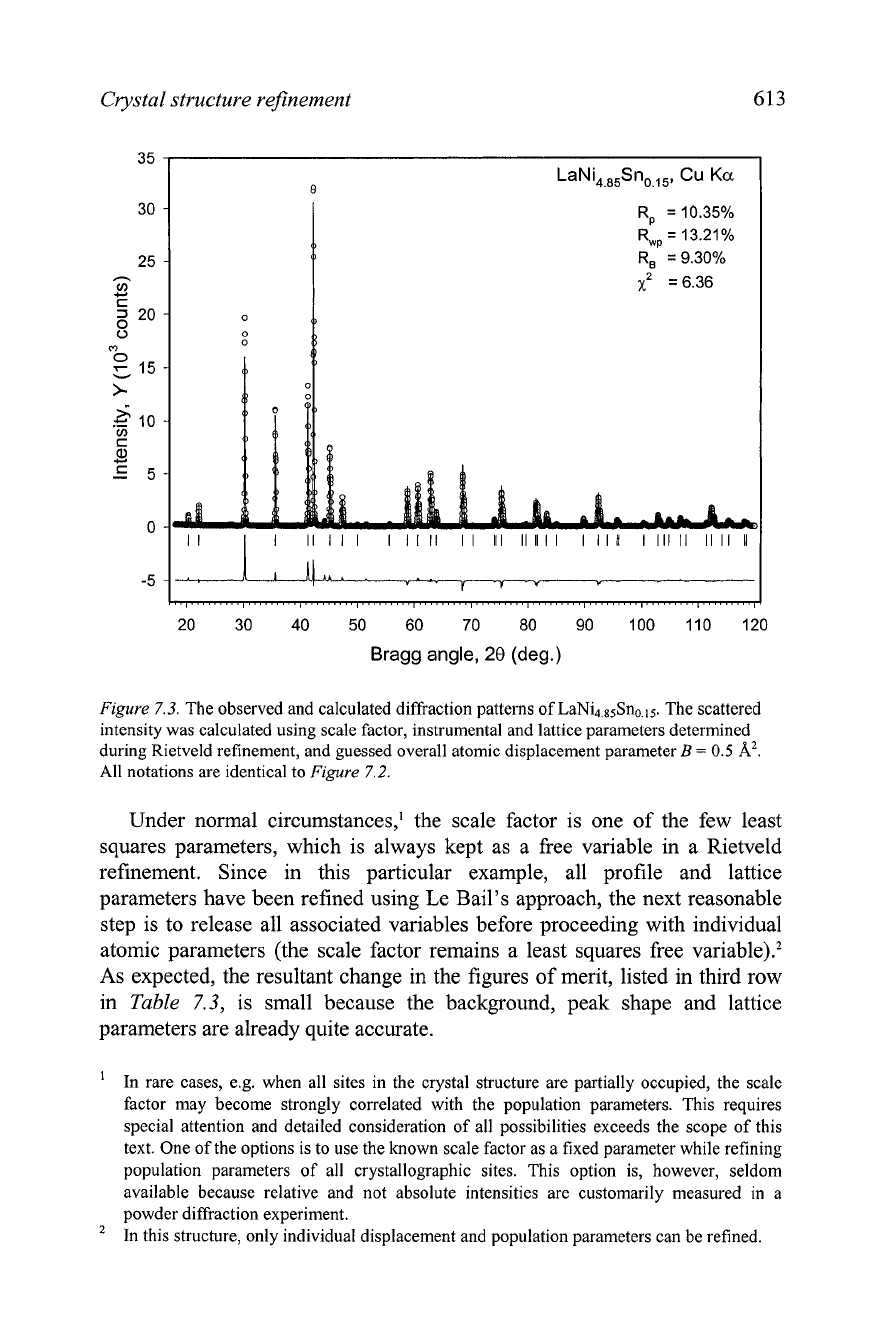
Crystal structure refinement
613
LaNi
,.,,
Sn
,,,,,
Cu
Ka
R,
=
10.35%
R,,
=
13.21%
R,
=
9.30%
X2
=
6.36
20 30 40 50 60 70 80 90 100 110 120
Bragg angle,
28
(deg.)
Figure
7.3.
The observed and calculated diffraction patterns of LaNi4,85Sno.15. The scattered
intensity was calculated using scale factor, instrumental and lattice parameters determined
during Rietveld refinement, and guessed overall atomic displacement parameter
B
=
0.5
A'.
All notations are identical to
Figure
7.2.
Under normal circumstances,' the scale factor is one of the few least
squares parameters, which is always kept as a free variable in a Rietveld
refinement. Since in this particular example, all profile and lattice
parameters have been refined using Le Bail's approach, the next reasonable
step is to release all associated variables before proceeding with individual
atomic parameters (the scale factor remains a least squares free
~ariable).~
As expected, the resultant change in the figures of merit, listed in third row
in
Table
7.3,
is small because the background, peak shape and lattice
parameters are already quite accurate.
In rare cases, e.g. when all sites in the crystal structure are partially occupied, the scale
factor may become strongly correlated with the population parameters. This requires
special attention and detailed consideration of all possibilities exceeds the scope of this
text. One of the options is to use the known scale factor as a fixed parameter while refining
population parameters of all crystallographic sites. This option is, however, seldom
available because relative and not absolute intensities are customarily measured in a
powder diffraction experiment.
'
In this structure, only individual displacement and population parameters can be refined.

614
Chapter
7
7.3.2 Overall atomic displacement parameter
So far, the only "structural" parameter included in the refinement was the
scale factor. This particular crystal structure has no free coordinates of
individual atoms
-
all are fixed by the symmetry of the occupied special
positions. Thus, given the relatively low values of all residuals and recalling
that at the beginning we assumed an arbitrary value for the overall atomic
displacement parameter (B
=
0.5 A2), it is time to include it into the least
squares minimization. The inconsistency of the randomly chosen overall
atomic displacement parameter is also easily distinguishable fi-om the plot of
the observed and calculated intensities, which is shown in
Figure
7.3. The
intensities of the majority of Bragg peaks observed at low angles exceed
calculated intensities but at high angles (20
>
-65") the relationships become
just the opposite. Given the effect of the atomic displacement parameters on
the integrated intensity as a function of Bragg angle (see
Eq.
2.91), it is easy
to conclude that the actual overall B is considerably higher than 0.5
A2.
The refinement of the overall B results in a significant reduction of all
residuals (fourth line in
Table
7.3), which is also expected since now we
have a realistic global estimate of thermal motions of atoms in the crystal
lattice of LaNi4,s5Sno.15. The refined value of the overall atomic displacement
parameter is B
=
1.32(2) A2, where the number in parenthesis indicates a
standard deviation in the last significant digit.
7.3.3 Individual parameters, free and constrained variables
At this point, we may begin to refine atomic displacement parameters of
the individual atoms. This is done by substituting individual B's (which were
kept at
0) by the refined overall atomic displacement parameter.
The overall
B
after this substitution should be set to
0.
The distribution of atoms in the
model of the crystal structure of LaNi4,~5Sn~.15 is such that two of the sites,
2(c) and 3(g), see
Table
7.2, are occupied by different types of atoms
simultaneously. Generally, atomic displacement parameters of different
atoms occupying the same crystallographic site should be constrained at
identical values.'
In
LHPM-Rietica and almost every other commonly available software
product, any dependent parameter, Pdependenr, may be constrained to any free
'
This is a reasonable simplification especially because it is nearly impossible to
differentiate properly between the vibrational motions of different atoms located in the
identical environment. Furthermore, individual displacement parameters of atoms
occupying the same crystallographic sites have a tendency to strong correlation, thus
causing severe instabilities of non-linear least squares. If a site has variable coordinate
parameters, the latter should be constrained equal for all atoms occupying the site due to
the same reasons.
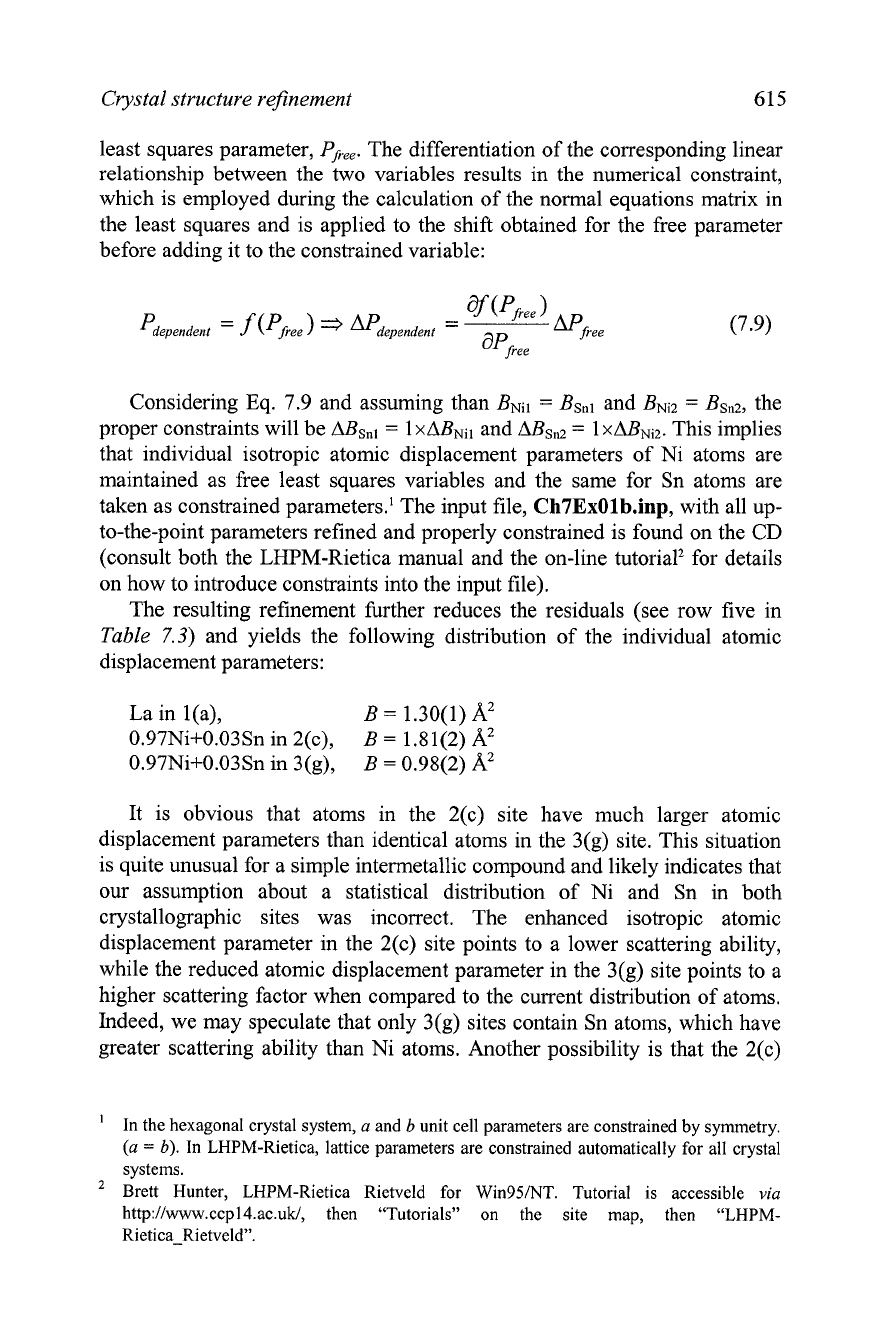
Crystal structure
refinement
615
least squares parameter,
PPee.
The differentiation of the corresponding linear
relationship between the two variables results in the numerical constraint,
which is employed during the calculation of the normal equations matrix in
the least squares and is applied to the shift obtained for the free parameter
before adding it to the constrained variable:
Considering Eq. 7.9 and assuming than BNil
=
BSnl and BNi2
=
BSn2, the
proper constraints will be ABsnl
=
1
x&il and ABs~
=
1
xABNi2. This implies
that individual isotropic atomic displacement parameters of Ni atoms are
maintained as free least squares variables and the same for Sn atoms are
taken as constrained parameters.' The input file,
Ch'lExOlb.inp,
with all up-
to-the-point parameters refined and properly constrained is found on the
CD
(consult both the LHPM-Rietica manual and the on-line tutorial2 for details
on how to introduce constraints into the input file).
The resulting refinement further reduces the residuals (see row five in
Table
7.3)
and yields the following distribution of the individual atomic
displacement parameters:
It is obvious that atoms in the 2(c) site have much larger atomic
displacement parameters than identical atoms in the
3(g) site. This situation
is quite unusual for a simple intermetallic compound and likely indicates that
our assumption about a statistical distribution of Ni and Sn in both
crystallographic sites was incorrect. The enhanced isotropic atomic
displacement parameter in the 2(c) site points to a lower scattering ability,
while the reduced atomic displacement parameter in the
3(g)
site points to
a
higher scattering factor when compared to the current distribution of atoms.
Indeed, we may speculate that only 3(g) sites contain Sn atoms, which have
greater scattering ability than Ni atoms. Another possibility is that the 2(c)
'
In the hexagonal crystal system,
a
and
b
unit cell parameters are constrained by symmetry.
(a
=
b).
In LHPM-Rietica, lattice parameters are constrained automatically for all crystal
systems.
Brett Hunter, LHPM-Rietica Rietveld for Win95/NT. Tutorial is accessible
via
http:llwww.ccpl4.ac.uW, then "Tutorials" on the site map, then
"LHPM-
Rietica-Rietveld".
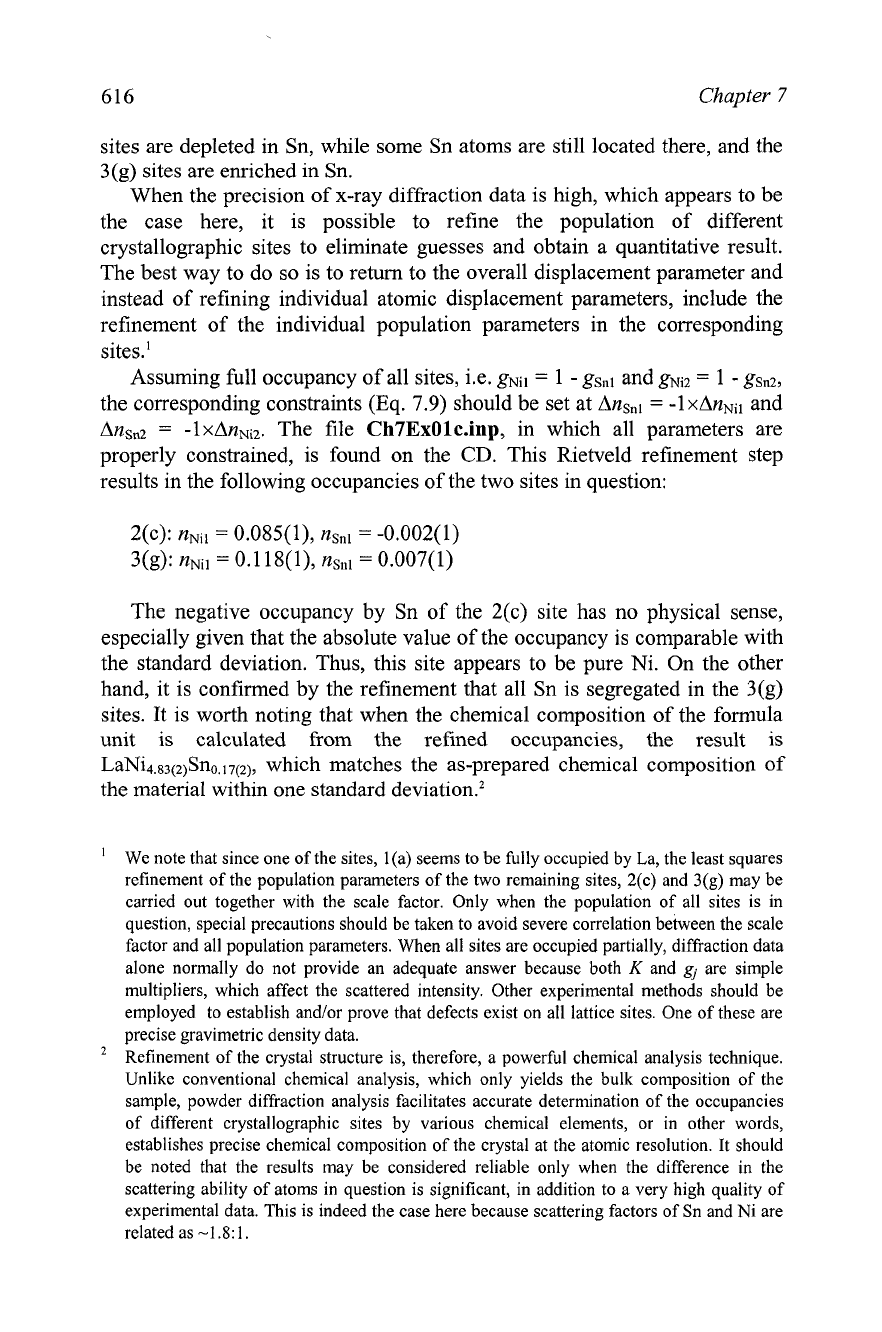
616
Chapter
7
sites are depleted in Sn, while some Sn atoms are still located there, and the
3(g)
sites are enriched in Sn.
When the precision of x-ray diffraction data is high, which appears to be
the case here, it is possible to refine the population of different
crystallographic sites to eliminate guesses and obtain a quantitative result.
The best way to do so is to return to the overall displacement parameter and
instead of refining individual atomic displacement parameters, include the
refinement of the individual population parameters in the corresponding
sites.'
Assuming
full occupancy of all sites, i.e.
gNil
=
1
-
gslll
and
g~i2
=
1
-
gsn2,
the corresponding constraints
(Eq.
7.9)
should be set at Ansnl
=
-1
xAnNil and
Ansn2.
=
-lxAnNi2. The file
Ch7ExOlc.inp,
in which all parameters are
properly constrained, is found on the
CD.
This Rietveld refinement step
results in the following occupancies of the two sites in question:
The negative occupancy by Sn of the
2(c) site has no physical sense,
especially given that the absolute value of the occupancy is comparable with
the standard deviation. Thus, this site appears to be pure Ni. On the other
hand, it is confirmed by the refinement that all Sn is segregated in the 3(g)
sites. It is worth noting that when the chemical composition of the forn~ula
unit is calculated from the refined occupancies, the result is
LaNi4.83c2,Sno.17(2), which matches the as-prepared chemical composition of
the material within one standard de~iation.~
We note that since one of the sites, l(a) seems to be fully occupied by La, the least squares
refinement of the population parameters of the two remaining sites, 2(c) and 3(g) may be
carried out together with the scale factor. Only when the population of all sites is in
question, special precautions should be taken to avoid severe correlation between the scale
factor and all population parameters. When all sites are occupied partially, diffraction data
alone normally do not provide an adequate answer because both
K
and are simple
multipliers, which affect the scattered intensity. Other experimental methods should be
employed to establish andlor prove that defects exist on all lattice sites. One of these are
precise gravimetric density data.
Refinement of the crystal structure is, therefore, a powerful chemical analysis technique.
Unlike conventional chemical analysis, which only yields the bulk composition of the
sample, powder diffraction analysis facilitates accurate determination of the occupancies
of different crystallographic sites by various chemical elements, or in other words,
establishes precise chemical composition of the crystal at the atomic resolution. It should
be noted that the results may be considered reliable only when the difference in the
scattering ability of atoms in question is significant, in addition to a very high quality of
experimental data. This is indeed the case here because scattering factors of Sn and Ni are
related as
-1.8:
1.

Crystal structure refinement 617
Proceeding with the refinement of the individual atomic displacement
parameters after removing Sn atoms from the 2(c) site and setting its
occupancy to
n~i~
=
0.08333 (the file
Ch7ExOld.inp
is located on the CD),
we find that the individual isotropic atomic displacement parameters of all
atoms become much closer to one another. The resultant residuals are listed
in row seven of Table 7.3.
7.3.4 Anisotropic atomic displacement parameters
The only remaining degree of freedom in this crystal structure is to refine
the displacement parameters of all atoms in the anisotropic approximation
(the presence of preferred orientation is quite unlikely since the used powder
was spherical and we leave it up to the reader to verify its absence by trying
to refine the texture using available experimental data). As noted in Chapter
2,
special positions usually mandate certain relationships between the
anisotropic atomic displacement parameters of the corresponding atoms. In
the space group P6/mmm, the relevant constraints are as follows:
After the individual isotropic atomic displacement parameters were
replaced by the properly constrained individual anisotropic displacement
parameters (LHPM-Rietica uses
Pij,
see Eq. 2.93), the refinement converges
to the residuals listed in row
8
of Table 7.3. The parameters of the fully
refined structure are found in the file
Ch7ExOle.inp
on the CD.
7.3.5 Multiple phase refinement
The presence of a minor second phase impurity can be added either in the
form of the actual structural model of Ni or as a Le Bail's phase, where only
the unit cell and peak shape parameters are taken into account. The latter
option has been chosen since we are not interested in the crystal structure of
this minor impurity, and it may be a difficult task given its small
contribution to the total scattered intensity.
The refinement with both crystalline phases contributing to the
computation of the scattered intensity (row
9,
Table 7.3) converges rapidly
and yields the residuals, which are only slightly higher than those, obtained
when no model of the crystal structure was present during a full pattern
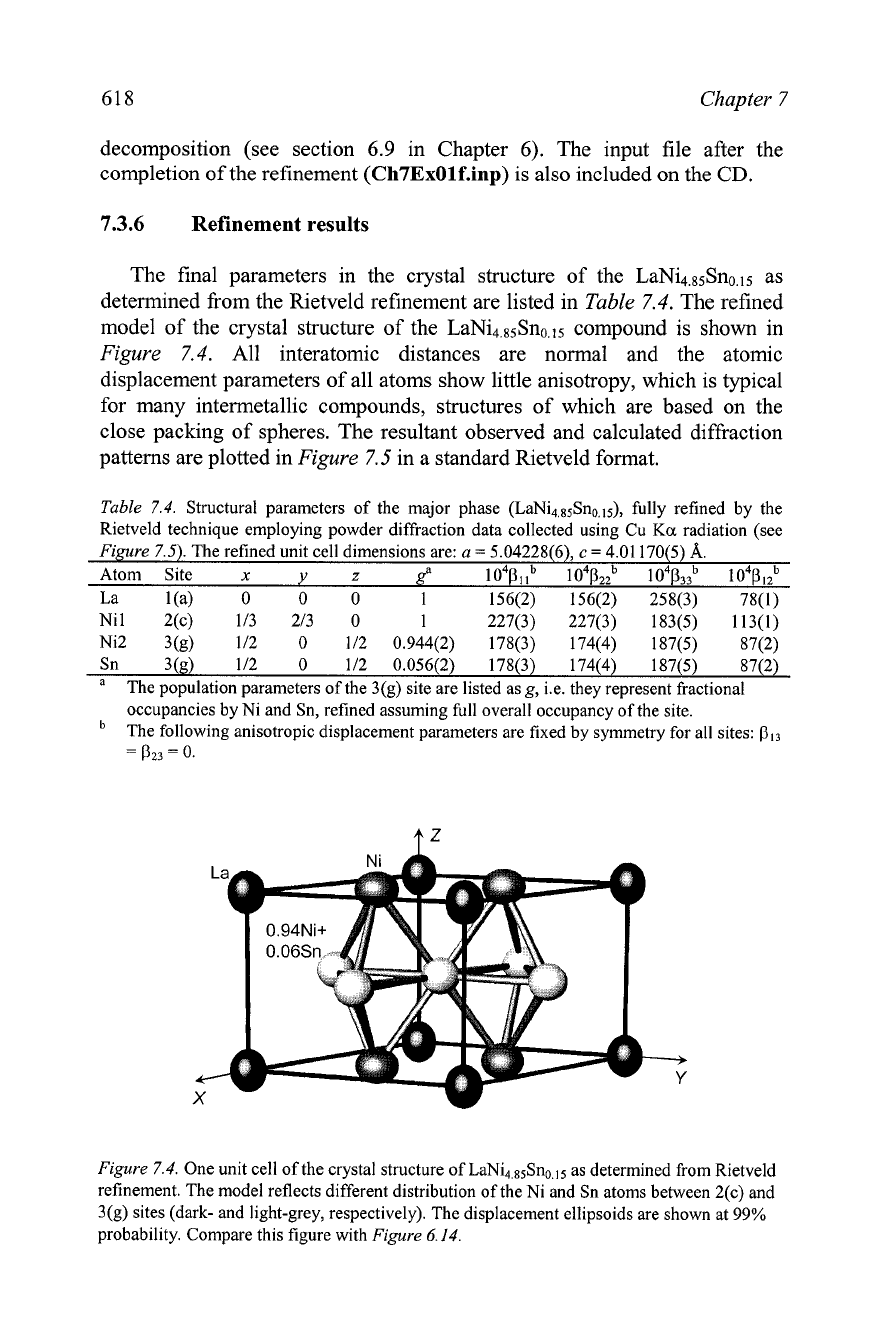
618
Chapter
7
decomposition (see section
6.9
in Chapter
6).
The input file after the
completion of the refinement
(Ch7ExOlf.inp)
is also included on the
CD.
7.3.6
Refinement results
The final parameters in the crystal structure of the LaNi4.85Sno.15 as
determined fi-om the Rietveld refinement are listed in
Table
7.4.
The refined
model of the crystal structure of the LaNi4,85Sno.ls compound is shown in
Figure
7.4.
All interatomic distances are normal and the atomic
displacement parameters of all atoms show little anisotropy, which is typical
for many intermetallic compounds, structures of which are based on the
close packing of spheres. The resultant observed and calculated diffraction
patterns are plotted in
Figure
7.5
in a standard Rietveld format.
Table
7.4. Structural parameters of the major phase (LaNi4,ssSno.ls), fully refined by the
Rietveld technique employing powder diffraction data collected using Cu
Ka
radiation (see
Figure
7.5). The refined unit cell dimensions are:
a
=
5.04228(6),
c
=
4.01 170(5)
A.
Atom Site
x
Y
z
ga
1 04pl
lb
lo4p22 1 04~33b 1 04p12
La l(a)
0
0 0 1 156(2) 156(2) 258(3) 78(1)
Nil 2(c) 113 213 0 1 227(3) 227(3) 183(5) 1 13(1)
Ni2 3(g) 112
0
112 0.944(2) 178(3) 174(4) 187(5) 87(2)
Sn 3(g) 112 0 112 0.056(2) 178(3) 174(4) 187(5) 87(2)
a
The population parameters of the 3(g) site are listed as
g,
i.e. they represent fractional
occupancies by Ni and Sn, refined assuming full overall occupancy of the site.
The following anisotropic displacement parameters are fixed
by
symmetry for all sites:
=p
-
23
-
0.
Figure
7.4. One unit cell of the crystal structure of LaNi4,85Sno.ls as determined from Rietveld
refinement. The model reflects different distribution of the Ni and Sn atoms between 2(c) and
3(g) sites (dark- and light-grey, respectively). The displacement ellipsoids are shown at 99%
probability. Compare this figure with
Figure
6.14.

Crystal structure refinement
619
LaNi
,,,,
Sn
,,,,,
Cu
Ka
R,
=
5.85%
R,,
=
8.07%
R,
=
3.10%
X2
=
2.38
20 30 40 50 60 70 80 90 100 110 120
Bragg angle,
20
(deg.)
Figure
7.5.
The observed and calculated diffraction patterns of LaNi4,85Sno,15 after the
completion of Rietveld refinement. Notations are identical to
Figure 7.2
and the second set of
vertical bars indicates the calculated positions
of
the
Ka,
components of Bragg peaks in the
impurity phase (solid solution of Sn in Ni).
7.3.7
Different radiation
The x-ray powder diffraction data were also collected from the same
specimen of LaNi4,85Sno.ls using Mo
Ka
radiation. The experimental data are
shown in
Figure
7.6.
One of the most obvious benefits of using higher
energy photons, is the greater volume of the reciprocal lattice, which can be
examined experimentally.
An
important advantage of including the data
measured at higher sinelh into the Rietveld refinement, is in obtaining more
accurate values of the individual atomic displacement parameters together
with the more precise site populations in this crystal structure. The better
accuracy, when compared to Cu
Ka
radiation, becomes obvious from a
simple analysis of Eqs. 2.89 and 2.91, which indicate that the effect of
varying
g
is independent of the Bragg angle, while the varying
B
has the
largest influence on the intensity, scattered at high sinO/L. Thus, by including
intensity scattered at high sin91h we reduce the correlation between the
atomic displacement and population parameters.
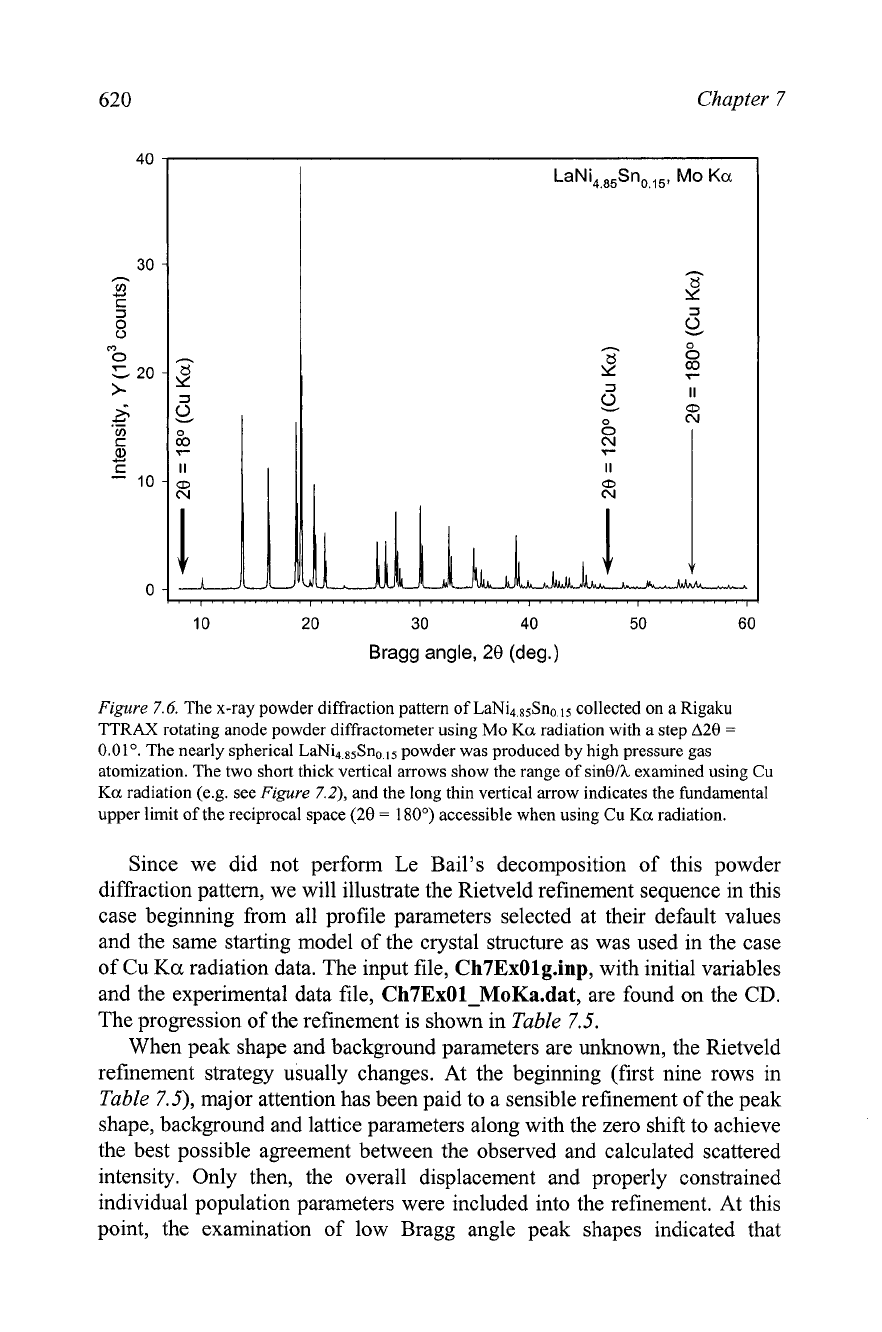
Chapter
7
10 20 30
40
50 60
Bragg angle,
20
(deg.)
Figure
7.6.
The x-ray powder diffraction pattern of LaNi4,85Sno collected on a Rigaku
TTRAX
rotating anode powder diffractometer using Mo Ka radiation with a step
A20
=
O.OlO.
The nearly spherical LaNi,8SSno
,,
powder was produced by high pressure gas
atomization. The two short thick vertical arrows show the range of sinelk examined using Cu
Ka radiation (e.g. see
Figure
7.2),
and the long thin vertical arrow indicates the fundamental
upper limit of the reciprocal space
(20
=
180')
accessible when using Cu
Ka
radiation.
Since we did not perform Le Bail's decomposition of this powder
diffraction
pattern, we will illustrate the Rietveld refinement sequence in this
case beginning from all profile parameters selected at their default values
and the same starting model of the crystal structure as was used in the case
of Cu
Ka
radiation data. The input file, Ch7ExOlg.inp, with initial variables
and the experimental data file, Ch7ExOl-MoKa.dat, are found on the
CD.
The progression of the refinement is shown in
Table
7.5.
When peak shape and background parameters are unknown, the Rietveld
refinement strategy usually changes. At the beginning (first nine rows in
Table
7.5), major attention has been paid to a sensible refinement of the peak
shape, background and lattice parameters along with the zero shift to achieve
the best possible agreement between the observed and calculated scattered
intensity. Only then, the overall displacement and properly constrained
individual population parameters were included into the refinement. At this
point, the examination of low Bragg angle peak shapes indicated that

Crystal structure reJinement
62
1
Howard's asymmetry approximation is not suitable and asymmetry was
changed to a more realistic Finger, Cox and Jephcoat model, as indicated in
the footnotes to
Table
7.5.
Table
7.5.
The progress of Rietveld refinement of the crystal structure of LaNi4.ssSno.,s using
powder diffraction data shown in
Figure
7.6.
Wavelengths used:
hKal
=
0.70932
A,
hKu2
=
0.71361
A.
Refined parameters
RD R,D RB
x2
Initial (all default, model from
Table
7.2)"
617.8 808.3 608.7 3x104
Scale factor
a
Scale factor plus linear background
a
Scale, linear background plus
U, V,
W
"
Scale, linear background,
U,
V,
Wplus qo
"
Scale, linear background,
U,
V,
W, qo,
a
and
c
a
Scale, linear background,
U,
V,
W,
qo,
a,
c
plus
asymmetry
"
Scale, linear background,
U,
V,
W,
qo,
a,
c,
asymmetry,
plus zero shift
a
Scale,
U,
V,
W, qo,
a,
c,
asymmetry, zero shift, plus
background (third order)
a
Scale,
U,
V,
W, qo,
a,
c,
asymmetry, zero shift, background
(third order) plus overall
B
a
Scale,
U,
V,
W,
qo,
a,
c,
asymmetry, zero shift, background
(third order), overall
B
plus individual population
parameters
"
Scale,
U,
V,
W,
qo,
a,
c,
zero shift, background (third
order), overall
B,
individual population parameters.
Asymmetry in
FCJ
approximation
Scale,
U,
V,
W,
qo,
a,
c,
asymmetry, zero shift, background
(third order), individual population parameters plus
individual anisotropic displacement parameters
b,C
Scale, all peak shape, lattice, zero shift, background (third
order), individual population and anisotropic parameters
b,C
All as above plus a second phase (Le Bail's
decom~osition)
b'C
"
Pseudo-Voigt peak shape function with Howard's asymmetry, see
Eq.
2.63.
Pseudo-Voigt peak shape function. Asymmetry was changed to Finger, Cox and Jephcoat
approximation, which better represents peak shapes measured on this powder
diffractometer using Mo
Ku
radiation, see section 6.10.
Population of the 2(c) site was set to pure Ni, while the population of the 3(g) site
remained free parameter.
Since the quality of this powder diffkaction pattern is excellent, we can
immediately switch to the refinement of the individual anisotropic
parameters. Furthermore, the presence of diffraction data at high
sinelh
enables us to refine the individual displacement and population
in the
3(g)
site simultaneously. Finally, the presence of an impurity was also
accounted as the "Le Bail's'' phase. The fully refined input data file,
